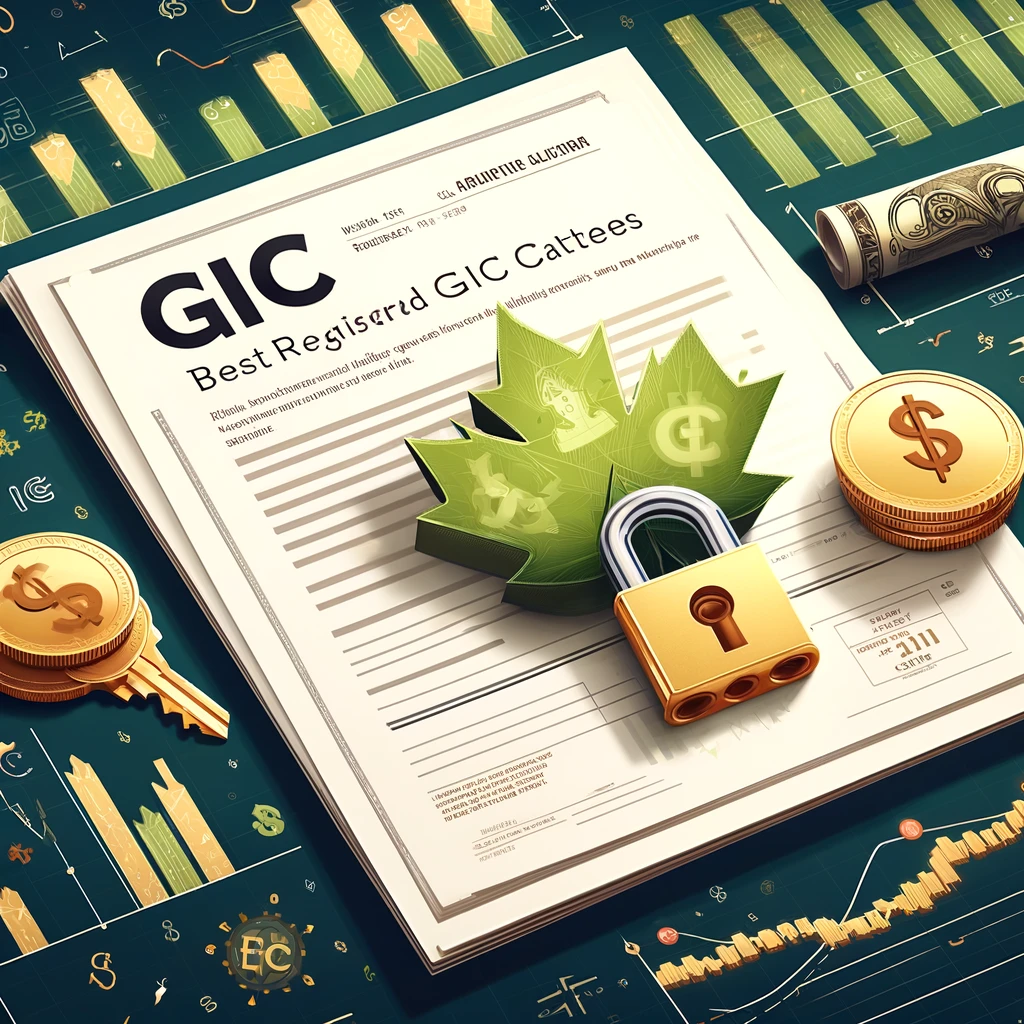In the realm of personal finance, securing your savings in a manner that ensures steady and reliable growth is paramount. One popular investment vehicle in Canada that caters to this need is the Guaranteed Investment Certificate (GIC). GICs are considered one of the safest investment options, offering a guaranteed return over a specified period. When these GICs are held within registered accounts such as Registered Retirement Savings Plans (RRSPs), Tax-Free Savings Accounts (TFSAs), or Registered Education Savings Plans (RESPs), they provide not only security but also significant tax advantages.
Understanding the nuances of GICs and how to maximize their benefits within registered accounts can be the key to a successful savings strategy. This guide aims to provide a comprehensive overview of the best registered GIC rates in Canada, shedding light on what makes a good GIC rate, how to find the best rates, and what factors to consider when choosing a GIC. We will explore various types of GICs, the advantages of using registered accounts, and tips for optimizing your investments. Whether you are a seasoned investor or new to the world of GICs, this guide will equip you with the knowledge to make prudent investment choices and optimize your savings strategy.
Best GIC Rates – Our Top Picks
What are registered GICs?
Registered Guaranteed Investment Certificates (GICs) are GICs held within registered accounts in Canada, such as Registered Retirement Savings Plans (RRSPs), Tax-Free Savings Accounts (TFSAs), and Registered Education Savings Plans (RESPs). These accounts provide tax advantages that enhance the benefits of GIC investments.
Key Features of Registered GICs
Tax Advantages:
- RRSPs: Contributions are tax-deductible, and the investments grow tax-free until withdrawal, at which point the funds are taxed as income.
- TFSAs: Contributions are made with after-tax dollars, but both the investment growth and withdrawals are tax-free.
- RESPs: Contributions grow tax-deferred, and withdrawals used for educational purposes may be taxed at the student’s lower income tax rate.
Safety and Security:
- Like all GICs, registered GICs offer a guaranteed return on investment, making them a low-risk option.
- They are insured by the Canada Deposit Insurance Corporation (CDIC) up to certain limits, adding an extra layer of security.
Fixed Terms and Interest Rates:
- Registered GICs have fixed terms ranging from a few months to several years.
- They provide a predetermined interest rate, ensuring a predictable return.
Types of GICs Available:
- Fixed-Rate GICs: Offer a set interest rate for the term of the GIC.
- Variable-Rate GICs: The interest rate can fluctuate based on market conditions.
- Cashable or Redeemable GICs: Allow early withdrawal with or without penalties.
- Non-Redeemable GICs: Funds are locked in until the end of the term.
Benefits of Registered GICs
- Tax Efficiency: Holding GICs in registered accounts maximizes tax benefits, leading to higher overall returns.
- Predictable Growth: Guaranteed returns make financial planning easier and reduce investment risk.
- Flexibility: A variety of GIC types and term lengths allows for customization according to individual financial goals and timelines.
Considerations
- Contribution Limits: Each registered account type has annual contribution limits and rules.
- Early Withdrawal Penalties: Some GICs may impose penalties for early withdrawal, reducing flexibility.
- Interest Rates: It’s important to shop around for the best rates, as they can vary significantly between financial institutions.
Registered GICs combine the security of traditional GICs with the tax benefits of registered accounts, making them an attractive option for conservative investors seeking steady, tax-efficient growth
How Do Registered GICs Work?
Registered Guaranteed Investment Certificates (GICs) operate similarly to regular GICs, but they are held within registered accounts, such as RRSPs, TFSAs, and RESPs, which provide specific tax advantages. Here’s a detailed look at how registered GICs work:
1. Opening a Registered Account
Before you can invest in a registered GIC, you need to open a registered account:
- RRSP (Registered Retirement Savings Plan): Primarily for retirement savings; contributions are tax-deductible, and growth is tax-deferred.
- TFSA (Tax-Free Savings Account): Contributions are made with after-tax dollars, and growth as well as withdrawals are tax-free.
- RESP (Registered Education Savings Plan): Used for education savings; contributions grow tax-deferred, and the government may provide additional grants.
2. Contributing Funds to the Account
After opening a registered account, you can contribute funds up to the annual or lifetime limits set by the Canadian government. Each type of registered account has specific contribution limits:
- RRSP: Contribution limit is based on your income, with a maximum annual limit.
- TFSA: Annual contribution limit is set by the government and accumulates if not used.
- RESP: Lifetime contribution limit per beneficiary, with annual limits to maximize grants.
3. Purchasing a GIC
Once funds are in the registered account, you can purchase a GIC:
- Choose a Term: GIC terms range from a few months to several years. Longer terms generally offer higher interest rates.
- Select a Type: Options include fixed-rate GICs, variable-rate GICs, cashable GICs, and non-redeemable GICs.
- Interest Rate: The interest rate is fixed or variable, depending on the type of GIC. Fixed-rate GICs provide a guaranteed return, while variable-rate GICs may offer higher potential returns tied to market performance.
4. Earning Interest
The financial institution holding the GIC pays interest according to the agreed-upon rate:
- Fixed-Rate GICs: Provide consistent interest payments over the term.
- Variable-Rate GICs: Interest payments fluctuate with market conditions.
- Compound Interest: Some GICs compound interest, meaning interest earned is reinvested and earns additional interest.
5. Maturity and Withdrawal
At the end of the GIC term (maturity), you can withdraw the principal and interest or reinvest it in another GIC. The process at maturity depends on the type of registered account:
- RRSP: Funds remain tax-deferred until withdrawal, at which point they are taxed as income.
- TFSA: Withdrawals are tax-free, and the withdrawal amount is added back to your contribution room for the following year.
- RESP: Withdrawals for educational purposes may be taxed in the beneficiary’s hands, often at a lower rate.
6. Reinvestment Options
Many investors choose to reinvest matured GICs to continue growing their savings. You can:
- Ladder GICs: Purchase multiple GICs with different maturity dates to balance access to funds and interest rates.
- Renewal: Roll over the principal and interest into a new GIC with the same or different terms.
Benefits and Considerations
- Tax Efficiency: Registered GICs maximize tax benefits, enhancing overall returns.
- Security: They provide a guaranteed return, minimizing investment risk.
- Flexibility: Various terms and types allow customization to fit individual financial goals.
- Early Withdrawal Penalties: Some GICs may impose penalties, affecting liquidity.
Registered GICs offer a safe, predictable way to grow your savings within the tax-advantaged environment of registered accounts, making them a valuable component of a diversified investment portfolio.
Pros and cons of registered GICs
Pros
Tax Advantages:
- RRSPs: Contributions are tax-deductible, and investments grow tax-free until withdrawal.
- TFSAs: Investment growth and withdrawals are tax-free.
- RESPs: Contributions grow tax-deferred, and government grants can enhance savings.
Guaranteed Returns:
- Registered GICs offer a fixed rate of return, ensuring that your principal and interest are secure and predictable.
Low Risk:
- GICs are one of the safest investment options since they are generally insured by the Canada Deposit Insurance Corporation (CDIC) up to certain limits.
Capital Preservation:
- The principal amount is protected, making GICs ideal for conservative investors or those nearing retirement.
Flexibility:
- A variety of GIC types (fixed-rate, variable-rate, cashable, non-redeemable) and terms (from a few months to several years) allows customization according to financial goals and risk tolerance.
Government Grants:
- In the case of RESPs, the government provides additional grants, boosting the overall savings for educational purposes.
Compound Interest:
- Some GICs offer compound interest, increasing the potential return over time.
Cons
Limited Liquidity:
- Non-redeemable GICs lock in your funds until maturity, which can be a disadvantage if you need access to your money earlier.
- Early withdrawal from redeemable GICs may incur penalties or lower interest rates.
Lower Returns:
- Compared to other investment options like stocks or mutual funds, GICs typically offer lower returns, which may not keep pace with inflation over the long term.
Contribution Limits:
- Registered accounts have annual and lifetime contribution limits, restricting the amount you can invest in registered GICs each year.
Taxable Withdrawals:
- RRSP withdrawals are taxed as income, which can be significant depending on your tax bracket at the time of withdrawal.
- RESP withdrawals for non-educational purposes are subject to tax and penalties.
Interest Rate Risk:
- Fixed-rate GICs lock in an interest rate for the term, which can be a disadvantage if market rates rise significantly.
- Conversely, variable-rate GICs may provide uncertain returns if market rates fall.
Opportunity Cost:
- Funds tied up in GICs are not available for potentially higher-yielding investments, leading to opportunity costs in a diversified portfolio.
Inflation Risk:
- The fixed returns on GICs may not keep up with inflation, reducing the purchasing power of your savings over time.
Registered GICs offer a safe and predictable investment option with significant tax advantages, making them an attractive choice for conservative investors. However, the trade-offs include limited liquidity, lower returns compared to higher-risk investments, and the potential for inflation to erode returns. Understanding these pros and cons is crucial for making informed decisions that align with your financial goals and risk tolerance.
What types of registered GICs are available in Canada?
In Canada, there are several types of Guaranteed Investment Certificates (GICs) that can be held within registered accounts such as RRSPs, TFSAs, and RESPs. Each type of GIC has unique features tailored to different investment needs and preferences. Here’s an overview of the various types of registered GICs available:
1. Fixed-Rate GICs
- Description: These GICs offer a fixed interest rate for the entire term of the investment.
- Benefits: Provide predictable and guaranteed returns, making them suitable for conservative investors.
- Considerations: The interest rate is locked in, which can be a disadvantage if market rates increase.
2. Variable-Rate GICs
- Description: The interest rate on these GICs can fluctuate based on changes in a benchmark rate, such as the prime rate.
- Benefits: Potential to earn higher returns if interest rates rise during the term.
- Considerations: Returns are less predictable, and interest rates can decrease.
3. Cashable or Redeemable GICs
- Description: These GICs allow the investor to withdraw funds before the maturity date, often after an initial lock-in period.
- Benefits: Provide flexibility and access to funds in case of emergencies.
- Considerations: May offer lower interest rates compared to non-redeemable GICs and could incur penalties for early withdrawal.
4. Non-Redeemable GICs
- Description: Funds are locked in for the full term, and early withdrawal is not permitted.
- Benefits: Typically offer higher interest rates compared to cashable GICs due to the commitment to keep funds invested for the entire term.
- Considerations: Lack of liquidity, making them less suitable for those who might need access to their funds before maturity.
5. Escalating Rate GICs
- Description: These GICs offer an interest rate that increases each year over the term of the investment.
- Benefits: Attractive for investors who want increasing returns over time and are willing to commit to a longer-term investment.
- Considerations: The average return may still be lower than some other investment options, depending on the initial rates.
6. Market-Linked or Index-Linked GICs
- Description: The return on these GICs is tied to the performance of a specific market index (e.g., S&P/TSX Composite Index).
- Benefits: Potential for higher returns based on market performance, while still protecting the principal.
- Considerations: Returns are not guaranteed and depend on market performance, which adds an element of risk.
7. Laddered GICs
- Description: This strategy involves purchasing multiple GICs with staggered maturity dates.
- Benefits: Provides regular access to a portion of the funds while maintaining the potential for higher returns on longer-term investments.
- Considerations: Requires managing multiple GICs and their respective maturity dates.
8. Registered Education Savings Plan (RESP) GICs
- Description: These GICs are specifically held within RESPs to save for a child’s education.
- Benefits: Contributions grow tax-deferred, and the government may provide additional grants (CESG).
- Considerations: Withdrawals must be used for educational purposes to maximize the benefits.
9. Registered Retirement Savings Plan (RRSP) GICs
- Description: Held within RRSPs to save for retirement, these GICs benefit from tax-deferred growth.
- Benefits: Contributions are tax-deductible, and investments grow tax-free until withdrawal.
- Considerations: Withdrawals are taxed as income, which can be significant depending on the tax bracket at the time of withdrawal.
10. Tax-Free Savings Account (TFSA) GICs
- Description: Held within TFSAs, these GICs provide tax-free growth and withdrawals.
- Benefits: No taxes on interest earned or withdrawals, offering great flexibility and tax efficiency.
- Considerations: Annual contribution limits apply, restricting the amount that can be invested each year.
Each type of registered GIC offers different benefits and considerations, allowing investors to choose the best option based on their financial goals, risk tolerance, and need for flexibility. Understanding the features of each type can help you make informed decisions and optimize your investment strategy.
How to find the best registered GIC rates in Canada
Finding the best registered GIC rates in Canada involves a combination of research, comparison, and understanding your financial goals. Here’s a step-by-step guide to help you secure the highest rates for your registered GICs:
1. Research Financial Institutions
- Major Banks: Start by checking the GIC rates offered by Canada’s major banks, such as RBC, TD, Scotiabank, BMO, and CIBC. These institutions often have competitive rates and special promotions.
- Credit Unions: Credit unions can offer attractive rates compared to major banks. Look into both local and national credit unions.
- Online Banks: Online banks, like EQ Bank and Tangerine, often provide higher rates due to lower overhead costs.
- Trust Companies: Specialized financial institutions, such as trust companies, might offer better rates for GICs.
2. Use Online Comparison Tools
- Rate Comparison Websites: Utilize websites that compare GIC rates across multiple financial institutions. Sites like Ratehub, Ratesupermarket, and Cannex provide up-to-date GIC rate comparisons.
- Bank Websites: Check the latest rates directly on the financial institutions’ websites to ensure you have the most current information.
3. Consider Promotional Rates
- Limited-Time Offers: Banks and credit unions occasionally offer promotional rates that are higher than their standard rates. These promotions can be seasonal or tied to specific marketing campaigns.
- Special Conditions: Be aware of any special conditions tied to promotional rates, such as minimum investment amounts or specific term lengths.
4. Evaluate Different Terms and Types
- Term Length: Generally, longer-term GICs offer higher interest rates. Compare rates for various term lengths (e.g., 1-year, 3-year, 5-year).
- Type of GIC: Fixed-rate, variable-rate, cashable, and non-redeemable GICs each have different rates. Decide which type suits your investment goals and compare the rates accordingly.
5. Check for Special Account Offers
- Registered Accounts: Some institutions offer higher rates for GICs held within registered accounts like RRSPs, TFSAs, and RESPs.
- Loyalty Programs: Certain banks offer better rates to customers who hold multiple products with them or participate in loyalty programs.
6. Contact Financial Advisors
- Personalized Advice: Speak with a financial advisor who can provide personalized advice and may have access to special rates or products not advertised publicly.
- Institutional Insights: Advisors can also help you understand the terms and conditions associated with different GICs and how they fit into your broader financial strategy.
7. Read the Fine Print
- Interest Calculation: Ensure you understand how interest is calculated (e.g., simple vs. compound interest) and when it is paid (e.g., annually, at maturity).
- Penalties and Fees: Check for any penalties associated with early withdrawal or fees that might reduce your overall returns.
8. Monitor Economic Conditions
- Interest Rate Trends: Keep an eye on the Bank of Canada’s interest rate decisions and economic outlook, as these can influence GIC rates. Higher central bank rates typically lead to higher GIC rates.
- Market Conditions: Stay informed about market trends and economic forecasts, which can impact the rates offered by financial institutions.
9. Review and Compare Regularly
- Ongoing Comparison: GIC rates can change frequently. Regularly review and compare rates to ensure you are getting the best deal, especially when renewing or purchasing new GICs.
- Reinvestment Opportunities: Consider laddering your GICs to take advantage of varying interest rates and maturities, providing flexibility and potentially higher returns over time.
By following these steps, you can effectively navigate the market and find the best registered GIC rates in Canada, ensuring your investments yield the highest possible returns within the safety and tax advantages of registered accounts.
What are common fees for registered GICs?
While Guaranteed Investment Certificates (GICs) are generally known for their simplicity and low fee structure, there are certain fees and costs associated with them, especially when held within registered accounts such as RRSPs, TFSAs, and RESPs. Here are some common fees to be aware of:
1. Account Maintenance Fees
- Registered Account Fees: Some financial institutions charge annual fees for maintaining registered accounts like RRSPs and RESPs. These fees can range from $25 to $100 or more annually.
- TFSA Fees: TFSAs typically have lower maintenance fees compared to RRSPs and RESPs, but some institutions might still charge an annual fee.
2. Early Withdrawal Penalties
- Cashable GICs: If you withdraw funds from a cashable GIC before the end of the term, you might incur an early withdrawal penalty. This penalty can include a reduction in the interest rate or a flat fee.
- Non-Redeemable GICs: These GICs generally do not allow early withdrawals. If an exception is made, significant penalties might apply, which can include forfeiting a portion or all of the earned interest.
3. Transfer Fees
- Transferring Registered Accounts: If you decide to transfer your registered GIC from one financial institution to another, there may be transfer fees involved. These fees typically range from $25 to $100 per transfer.
- Partial Transfers: Some institutions might charge additional fees for partial transfers of your GIC holdings.
4. Redemption Fees
- Early Redemption Fees: Besides penalties for early withdrawal, some GICs might have specific redemption fees if cashed out before maturity. These fees can vary based on the institution’s policies.
5. Administrative Fees
- Account Changes: Fees may apply for administrative changes such as changing the beneficiary on an RESP or altering the investment instructions on an RRSP.
- Statement Fees: While most institutions provide electronic statements for free, some might charge for paper statements or additional copies of account statements.
6. Foreign Currency Fees
- Currency Exchange Fees: If you invest in foreign currency GICs, there might be fees associated with currency exchange.
- Foreign GIC Fees: Additional fees might apply for GICs denominated in foreign currencies, such as administrative or processing fees.
7. Withdrawal Fees
- Registered Account Withdrawals: Withdrawing funds from registered accounts like RRSPs before retirement age can incur withholding taxes and possibly additional fees from the financial institution.
- TFSA Withdrawals: While TFSA withdrawals are tax-free, some institutions might charge a fee for multiple withdrawals within a certain period.
8. Advisory Fees
- Financial Advisor Fees: If you purchase your GIC through a financial advisor or planner, there may be advisory fees, either as a flat fee or a percentage of the investment.
9. Other Miscellaneous Fees
- Dormant Account Fees: Some institutions charge fees on dormant or inactive accounts after a certain period of inactivity.
- Custodial Fees: Custodial fees may be charged for holding certain types of investments within registered accounts.
Tips to Avoid or Minimize Fees
- Compare Institutions: Shop around and compare fees across different financial institutions. Some banks and credit unions offer fee waivers or lower fees for registered accounts.
- Negotiate Fees: Sometimes, you can negotiate with your financial institution to reduce or waive certain fees, especially if you hold multiple accounts or have a substantial investment with them.
- Read the Fine Print: Always read the terms and conditions associated with GICs and registered accounts to fully understand the fee structure and avoid unexpected charges.
Understanding these common fees can help you make more informed decisions when investing in registered GICs, ensuring that you maximize your returns while minimizing costs.
What are the requirements to apply for a registered GIC?
Applying for a registered Guaranteed Investment Certificate (GIC) in Canada involves meeting specific eligibility criteria and completing certain steps to open and fund the appropriate registered account. Here’s a detailed look at the requirements:
1. Eligibility Criteria
Age Requirements:
- RRSP: You must be under 71 years old as RRSPs must be converted to a RRIF (Registered Retirement Income Fund) or annuity by the end of the year you turn 71.
- TFSA: You must be at least 18 years old (19 in some provinces) to open a TFSA.
- RESP: There are no specific age requirements for the subscriber (the person opening the account), but the beneficiary (the person for whom the RESP is opened) must be a Canadian resident under the age of 18 to receive government grants.
Residency:
- You must be a Canadian resident for tax purposes to contribute to registered accounts like RRSPs, TFSAs, and RESPs.
Social Insurance Number (SIN):
- A valid SIN is required to open and contribute to registered accounts in Canada.
2. Opening the Registered Account
Before investing in a registered GIC, you need to open the appropriate registered account:
RRSP (Registered Retirement Savings Plan):
- Complete an application form provided by the financial institution.
- Provide personal identification and your SIN.
- Designate a beneficiary, if desired.
TFSA (Tax-Free Savings Account):
- Complete an application form.
- Provide personal identification and your SIN.
- Ensure you adhere to the annual contribution limits set by the government.
RESP (Registered Education Savings Plan):
- Complete an application form.
- Provide your SIN and the beneficiary’s SIN.
- Choose the type of RESP (individual, family, or group).
3. Funding the Registered Account
Initial Deposit:
- Deposit funds into the registered account. Some financial institutions may have a minimum deposit requirement for opening a GIC.
Contribution Limits:
- RRSP: Contributions are limited to 18% of your previous year’s earned income, up to a maximum annual limit set by the government.
- TFSA: There is an annual contribution limit set by the government, which accumulates if not used.
- RESP: There is a lifetime contribution limit of $50,000 per beneficiary, and annual contributions may be required to maximize government grants.
4. Selecting the GIC
Choose the Term and Type:
- Decide on the term length (e.g., 1 year, 3 years, 5 years) and type of GIC (e.g., fixed-rate, variable-rate, cashable, non-redeemable).
Compare Rates:
- Shop around for the best GIC rates offered by banks, credit unions, and other financial institutions.
5. Application Process
Complete the Application Form:
- Provide necessary personal information, including your SIN and details about the registered account.
- Specify the amount you wish to invest and the term of the GIC.
Submit Required Documentation:
- Submit identification documents and proof of residency if required.
- Provide the initial deposit as per the financial institution’s requirements.
Review and Sign:
- Carefully review the terms and conditions of the GIC.
- Sign the application form and any other required documents.
6. Confirmation and Issuance
Receive Confirmation:
- After processing your application, the financial institution will confirm the purchase of the GIC and provide details such as the interest rate, term length, and maturity date.
Certificate Issuance:
- Some institutions provide a physical or digital certificate as proof of your GIC investment.
Tips for a Smooth Application Process
Ensure Compliance:
- Make sure you are within your contribution limits for RRSPs and TFSAs to avoid penalties.
- Regularly monitor your contribution room, especially for TFSAs, to maximize your tax-free savings.
Stay Informed:
- Keep up-to-date with the latest rules and contribution limits for registered accounts, as they can change annually based on government regulations.
Consult a Financial Advisor:
- Consider seeking advice from a financial advisor to ensure that your investment strategy aligns with your long-term financial goals and to help navigate the application process.
By meeting these requirements and following the appropriate steps, you can successfully apply for a registered GIC in Canada and take advantage of the tax benefits and security that these investment products offer.
Registered vs. non-registered GICs
Guaranteed Investment Certificates (GICs) are popular investment options in Canada, offering a secure way to grow savings over a fixed period. Understanding the differences between registered and non-registered GICs can help investors make informed decisions based on their financial goals, tax considerations, and risk tolerance. Here’s a comparison of the two:
Registered GICs
Tax-Advantaged Accounts:
- Registered GICs are held within registered accounts like RRSPs, TFSAs, and RESPs.
- Contributions to these accounts offer tax benefits such as tax-deferred growth (RRSPs), tax-free growth and withdrawals (TFSAs), or tax-deferred growth and government grants (RESPs).
Tax Implications:
- RRSPs: Withdrawals from RRSPs are taxed as income, providing a tax deferral benefit during the contribution phase and ideally a lower tax rate during the withdrawal phase in retirement.
- TFSAs: Contributions are made with after-tax dollars, and both growth and withdrawals are tax-free, offering flexibility and tax efficiency.
- RESPs: Contributions grow tax-deferred, and government grants are available to boost savings. Withdrawals are taxed in the beneficiary’s hands, often at a lower rate.
Contribution Limits:
- Registered accounts have annual contribution limits and rules determined by the Canadian government. Exceeding these limits can result in penalties.
Government Grants:
- RESPs may qualify for government grants such as the Canada Education Savings Grant (CESG), enhancing savings for education.
Withdrawal Restrictions:
- Early withdrawals from registered accounts may be subject to penalties, tax implications, or loss of government grants, depending on the account type and purpose of the withdrawal.
Non-Registered GICs
No Tax Advantages:
- Non-registered GICs are held outside of registered accounts and do not offer the same tax benefits as registered accounts.
- Interest earned on non-registered GICs is fully taxable in the year it is received, potentially resulting in higher taxes, especially for investors in higher tax brackets.
Flexibility:
- Non-registered GICs offer more flexibility in terms of contribution amounts and withdrawal options compared to registered accounts.
- There are no contribution limits or restrictions on withdrawals, allowing investors to access their funds more readily if needed.
No Contribution Limits:
- There are no annual contribution limits for non-registered GICs, allowing investors to invest any amount they choose.
Tax Reporting:
- Interest earned on non-registered GICs must be reported on annual tax returns and is taxed at the investor’s marginal tax rate.
No Withdrawal Penalties:
- Non-registered GICs typically do not have early withdrawal penalties, providing greater liquidity and accessibility to funds.
Summary
- Registered GICs offer tax advantages and government grants within registered accounts, making them ideal for long-term savings goals like retirement or education.
- Non-registered GICs provide flexibility and accessibility but lack the tax benefits of registered accounts.
- Choosing between registered and non-registered GICs depends on factors such as tax considerations, investment goals, and liquidity needs. It’s essential to weigh the advantages and disadvantages of each option based on your individual financial situation.
Alternatives to registered GICs
While Registered Guaranteed Investment Certificates (GICs) offer security and tax advantages within registered accounts, investors may also consider alternative investment options to diversify their portfolios or achieve different financial goals. Here are some alternatives to registered GICs to consider:
1. Non-Registered GICs
- Description: GICs held outside of registered accounts, offering flexibility and accessibility.
- Benefits: No contribution limits or restrictions on withdrawals, providing liquidity and ease of access to funds.
- Considerations: Interest earned is fully taxable, and there are no tax-deferral or tax-free growth benefits.
2. High-Interest Savings Accounts (HISAs)
- Description: Savings accounts that offer higher interest rates than traditional savings accounts.
- Benefits: Greater liquidity and flexibility compared to GICs, with no lock-in period.
- Considerations: Interest rates may fluctuate, and returns may be lower than GICs, especially for longer terms.
3. Bond Funds
- Description: Mutual funds or exchange-traded funds (ETFs) that invest in a diversified portfolio of bonds.
- Benefits: Potential for higher returns than GICs with moderate risk, offering diversification and professional management.
- Considerations: Bond funds are subject to interest rate risk and market fluctuations, and returns are not guaranteed.
4. Stocks and Equity Funds
- Description: Ownership shares in individual companies or pooled investments in diversified portfolios of stocks.
- Benefits: Potential for higher long-term returns compared to GICs, with the opportunity for capital appreciation.
- Considerations: Stocks are subject to market volatility and higher risk, and returns are not guaranteed. Professional advice may be necessary for proper portfolio diversification.
5. Real Estate Investment Trusts (REITs)
- Description: Investments in companies that own, operate, or finance income-generating real estate properties.
- Benefits: Offers exposure to real estate markets and potential for regular income through dividends.
- Considerations: REITs can be subject to market fluctuations and risks associated with real estate investments.
6. Dividend-Paying Stocks
- Description: Stocks of companies that regularly distribute a portion of their earnings to shareholders in the form of dividends.
- Benefits: Provides regular income and potential for capital appreciation, offering a combination of income and growth.
- Considerations: Dividend payouts are not guaranteed and can fluctuate based on company performance and economic conditions.
7. Balanced Funds
- Description: Mutual funds or ETFs that invest in a mix of stocks, bonds, and other asset classes to achieve a balanced risk-return profile.
- Benefits: Offers diversification across asset classes, with professional management to adjust allocations based on market conditions.
- Considerations: Balanced funds may have higher fees compared to individual investments, and returns are subject to market fluctuations.
8. Index Funds
- Description: Mutual funds or ETFs that track a specific market index, such as the S&P 500 or TSX Composite Index.
- Benefits: Low-cost investment option with diversification across a broad market, typically offering competitive returns over the long term.
- Considerations: Returns are tied to the performance of the underlying index, and there is limited ability to outperform the market.
9. Exchange-Traded Funds (ETFs)
- Description: Investment funds traded on stock exchanges, representing a basket of securities such as stocks, bonds, or commodities.
- Benefits: Offers diversification, liquidity, and low-cost access to various asset classes and markets.
- Considerations: ETFs are subject to market risk and may have management fees and trading costs.
10. Alternative Investments
- Description: Investments outside of traditional asset classes, such as private equity, hedge funds, or commodities.
- Benefits: Offers diversification and potential for uncorrelated returns, providing exposure to different market dynamics.
- Considerations: Alternative investments can be complex, illiquid, and have higher fees compared to traditional investments, requiring careful due diligence and risk assessment.
Summary
Exploring alternatives to registered GICs allows investors to tailor their portfolios to meet specific investment objectives, risk tolerance, and time horizon. Whether seeking income, growth, or diversification, there are various investment options available to complement or replace registered GICs based on individual preferences and financial circumstances. Consulting with a financial advisor can help assess the suitability of different alternatives and construct a well-rounded investment strategy.
FAQs about the best registered GIC rates in Canada
Registered Guaranteed Investment Certificates (GICs) are investment products held within registered accounts like RRSPs, TFSAs, and RESPs in Canada. They offer tax advantages and government grants, making them attractive options for long-term savings goals.
Registered GICs offer tax benefits such as tax-deferred growth (RRSPs), tax-free growth and withdrawals (TFSAs), or tax-deferred growth and government grants (RESPs). Non-registered GICs do not offer these tax advantages but provide greater flexibility in terms of contributions and withdrawals.
Benefits of registered GICs include tax advantages, government grants (for RESPs), security of principal, guaranteed returns, and various types and terms to suit different investment goals and risk tolerances.
To find the best rates, compare offerings from different financial institutions, including major banks, credit unions, and online banks. Use rate comparison websites, check bank websites directly, and consider promotional rates and special conditions.
Types of registered GICs include fixed-rate, variable-rate, cashable, non-redeemable, escalating rate, market-linked, laddered, and those specifically designed for RRSPs, TFSAs, and RESPs.
Fees associated with registered GICs may include account maintenance fees, early withdrawal penalties, transfer fees, redemption fees, administrative fees, and foreign currency fees, among others.
To apply, ensure you meet eligibility criteria, open the appropriate registered account, fund the account, select the GIC type and term, complete the application process, and review and sign the necessary documents.
Alternatives include non-registered GICs, high-interest savings accounts, bond funds, stocks and equity funds, real estate investment trusts (REITs), dividend-paying stocks, balanced funds, index funds, ETFs, and alternative investments.
To maximize benefits, consider contributing the maximum allowable amount to registered accounts each year, take advantage of government grants for RESPs, shop around for the best rates, and ensure compliance with contribution limits and withdrawal rules.
Registered GICs can be suitable for various investors, depending on their financial goals, risk tolerance, and tax situation. However, it’s essential to consider individual circumstances and consult with a financial advisor to determine suitability and create a diversified investment strategy.
In conclusion, finding the best registered GIC rates in Canada requires thorough research, comparison, and understanding of your financial goals and circumstances. Registered GICs offer tax advantages, security, and various options tailored to meet long-term savings objectives within registered accounts like RRSPs, TFSAs, and RESPs. By comparing rates from different financial institutions, considering promotional offers, and staying informed about changes in interest rates and government regulations, investors can maximize their returns while benefiting from the tax-efficient growth and guaranteed returns offered by registered GICs. It’s essential to assess individual needs, seek professional advice if necessary, and construct a well-rounded investment portfolio that balances risk and reward to achieve long-term financial success.




















